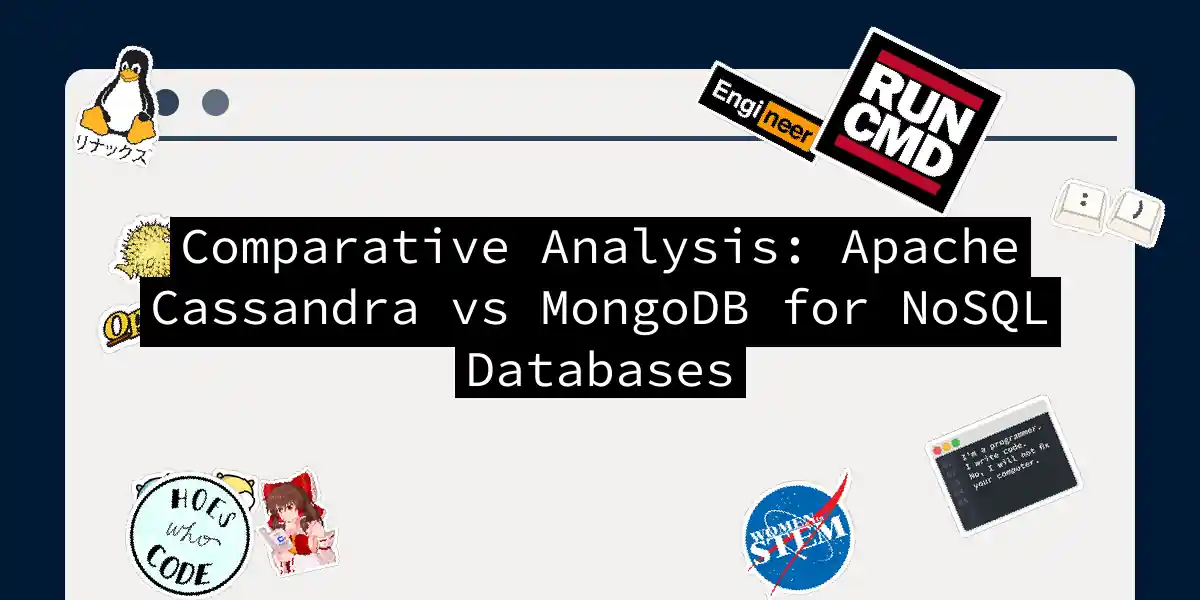When it comes to the world of NoSQL databases, two names often come to the forefront: Apache Cassandra and MongoDB. Both are powerhouses in their own right, but they cater to different needs and offer unique strengths. In this article, we’ll delve into the details of each, comparing their architectures, performance, scalability, and use cases, all while adding a dash of personality to keep things engaging.
Data Models: The Heart of the Matter
Cassandra: The Wide-Column Store
Apache Cassandra is a wide-column store database, which means it stores data in columns instead of rows. This model is particularly useful for handling large amounts of distributed data. Imagine a spreadsheet where each row can have different columns, and you’re close to understanding Cassandra’s data model.
Cassandra uses a partitioned row store data model, distributing data across a cluster based on the primary key. Each part of the data is saved on a separate server, making it highly scalable and fault-tolerant.
MongoDB: The Document-Oriented Database
MongoDB, on the other hand, is a document-oriented database. It stores data in JSON-like documents called BSON (Binary Serialized Object Notation). These documents are flexible and can contain nested structures, making MongoDB a favorite for applications with evolving data requirements.
MongoDB organizes its documents into collections, similar to tables in relational databases. This flexibility in schema design is a significant advantage, especially for applications that need to adapt quickly to changing data structures.
Architecture: The Backbone of Scalability
Cassandra: Decentralized and Masterless
Cassandra’s architecture is decentralized and masterless, meaning every node in the cluster is equal and can handle read and write operations. This design ensures high availability and fault tolerance, as there is no single point of failure. If one node fails, the others can continue to operate without interruption.
MongoDB: Master-Slave Replication
MongoDB uses a master-slave replication architecture, where one node is the primary (master) and the others are secondary (slaves). The primary node accepts write operations, while the secondary nodes can handle read operations. This architecture can lead to a slight delay in failover if the primary node fails, but it is still highly reliable.
Scalability: The Ability to Grow
Cassandra: Linear Scalability
Cassandra is renowned for its linear scalability. You can add more nodes to the cluster as needed, and the system will distribute the load efficiently. This makes Cassandra ideal for applications that require high write throughput and low latency, such as real-time analytics and IoT platforms.
MongoDB: Horizontal Scaling with Sharding
MongoDB also scales horizontally using sharding, where data is distributed across multiple servers. While MongoDB’s scalability is robust, it requires more setup and configuration compared to Cassandra. However, MongoDB’s sharding technique allows it to handle large amounts of data and traffic effectively.
Performance: The Speed and Efficiency
Cassandra: Optimized for Writes
Cassandra is optimized for write-heavy workloads, providing high write throughput and low latency. It uses a storage engine that ensures constant-time writes, regardless of the data size. This makes Cassandra a top choice for applications that require fast and reliable write operations.
MongoDB: Fast Reads and Writes
MongoDB offers fast read and write operations, especially for simple queries. However, complex queries and aggregations can be slower compared to Cassandra. MongoDB’s use of indexes, including single-field, compound, and geospatial indexes, enhances query performance significantly.
Query Language and Aggregation
Cassandra: CQL and External Aggregation
Cassandra uses the Cassandra Query Language (CQL), which is similar to SQL and easy to learn for those familiar with relational databases. However, Cassandra lacks a built-in aggregation framework and relies on external tools like Apache Hadoop and Spark for complex queries.
MongoDB: Rich Query Language and Built-in Aggregation
MongoDB supports a rich query language that includes field, range, and regular expression queries. It also has a built-in aggregation framework that allows for complex data transformations and analysis. This makes MongoDB a powerful tool for data analytics and reporting.
Management and Community
Cassandra: Complex but Robust
Managing Cassandra can be complex, especially for beginners. It requires careful configuration and monitoring of the cluster. However, Cassandra has a large and active open-source community, which provides extensive support and resources.
MongoDB: Easier to Manage
MongoDB is generally easier to manage, especially for smaller deployments. It has a more flexible schema and requires less upfront configuration. MongoDB also has a strong community and extensive documentation, making it easier for developers to get started and maintain their databases.
Use Cases: Where to Use Each
Cassandra: Real-Time Analytics and IoT
Cassandra is ideal for applications that require high availability, fault tolerance, and linear scalability. Use cases include real-time analytics, IoT platforms, and any scenario where write-heavy workloads are common. Companies like Twitter, Netflix, and Lyft rely on Cassandra for its robust performance and scalability.
MongoDB: Content Management and E-Commerce
MongoDB is well-suited for applications with evolving data requirements and complex data structures. It’s a favorite for content management systems, e-commerce platforms, and any scenario where flexible schema design and rich query capabilities are needed. Companies like LinkedIn, eBay, and SAP use MongoDB for its flexibility and performance.
Conclusion
Choosing between Apache Cassandra and MongoDB is not a one-size-fits-all decision. It depends on your specific needs and the characteristics of your project. If you need a highly scalable, write-optimized database with strong consistency, Cassandra might be your best bet. However, if you require a flexible schema, rich query capabilities, and ease of development, MongoDB is the way to go.
In the end, both databases are powerful tools in the NoSQL arsenal, each with its unique strengths and weaknesses. By understanding these differences, you can make an informed decision that will help your application thrive in the ever-demanding world of software development.
So, the next time you’re deciding between these two NoSQL giants, remember: Cassandra is like the reliable, hardworking engineer who ensures your data is always available and written efficiently, while MongoDB is like the agile, creative developer who loves flexible schemas and powerful queries. Choose wisely, and your application will thank you
